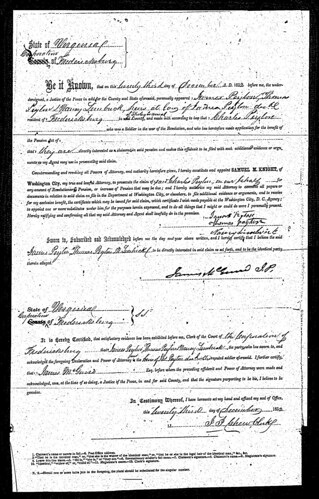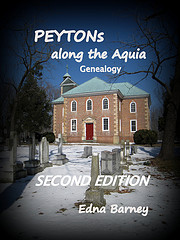Edna: Attached are my information and sources on John Patton b. 1777 No. Carolina, father of Sarah Royston Patton b. 1804. Sarah married a brother of one of my direct ancestors (Aaron Foster b. 1804 Nicholas, KY). I believe my information on John’s father, George Patton (b. abt 1745), came from ancestry.com. I also found George’s father there, named Robert Patton, b. abt 1720 Ireland, who married Unknown Espy, also born in Ireland. Apparently the 1880 Census of McLean Co., Illinois shows Benjamin Patton (son of John Patton), and states that his father was born in North Carolina.
Aaron Foster, husband of Sarah Royston Patton, is the grandson of William Peyton Foster, b. 1747 Broadrun Estate, Prince William, Virginia. Since William Peyton has so many grandchildren named Peyton Foster, this seems to be a big name in our lineage. It’s also highly interesting that William Peyton Foster and Timothy Peyton were such good friends. I am very interested in the deed you mentioned regarding Timothy Peyton and a FOSTER in PW County. If you happen to locate it could you please email me a copy, or let me know where I can find the original? I would be very grateful.
Please feel free to publish my letter on your guestbook, along with my email address. I like to be available to people who may be related so we can share information and perhaps be lead to new source data. Adrienne Foster Potter
JOHN PATTON b. 1777 NC
“General Bartholomew (a revolutionary war veteran and an early settler of McLean, Ill) believed in preparedness, hence he advised the building of rude forts, or block houses as means of defense. One such was erected at the home of John Patton near Selma in Lexington Township and the Henlines also erected one.”-History of McLean County, Illinois, by Jacob L. Hasbrouck, pg. 111 1880 Census of Lexington, McLean Illinois, of his son Benjamin, it states that John Patton was born in North Carolina.
“Seedlings of William Foster,” by Flavius Foster, Bk II, Pg. 131
“#3, John Patton, son of George, was born in North Carolina, and moved to Garrard County, Kentucky. Here he acquired land, and built his first home. Here too, he met and married Margaret Wiley, pg. 136, and their first seven children were born.
In the fall of 1817, John & Margaret Patton moved to Switzerland Co., Indiana, where they built their second home. Eleven years later, news of wild, rich land in Illinois, just waiting for a plow, could be had for a song. John could not resist such a siren call. He sold all his unmovable goods, and loaded the rest, including his family, into two wagons. The lead wagon was pulled by a 4-horse team, the second, the heavier loaded, was pulled by two yoke of oxen. A band of sheep and cattle were driven by the older children. (Note Aaron Foster chapter)
After a wet miserable drive, the Patton convoy arrived in McLean Co., Illinos, November 1827. With John was his son-in-law, Aaron Foster, who was lucky enough to get food and shelter for his family by doing chores for a settler. The Pattons were not so lucky. They wintered in a pole cabin, with their small children. There was no fireplace or chinking between the logs. They did their cooking out-of-doors, and their living quarters were little better than living outside.
The next spring, John Patton was all set to erect a cabin on the prairie, when two hunters stopped for a bit. They told John of a fine stand of timber, with a river flowing through that would make a nice homesite. John’s inspection of the site proved to be just what he had always dreamed of owning. In later years, this fine stand of oak, maple and walnut trees, and river came to be known as, “The Patton Settlement.”
The Pattons and Aaron Foster moved into some apparently abandoned Indian teepees, and began cutting logs for a cabin. The first trees felled were of walnut, due to its resistance to ground contact and termites. While they were thus employed, the Indians put in an appearance. They had not abandoned their town, as John Patton had thought, but had been in their winter camp, hunting throughout the winter.
At first the Indians, of the Kickapoo tribe, insisted that the white men leave. But after some bargaining, during which John made them some furniture, repaired some broken guns, and agreed to fence off their ancient burial grounds, the Indians gave him the land. Some of the Indians, with some white men who had wintered nearby, helped John to erect his cabin. Soon after, these Indians joined another group of their tribesmen, who had a town about 50 miles away.”
Insert by Adrienne Potter: The Kickapoo Indians had earlier kicked out other white families, such as John Hendrix, the Dawson family, Thomas Orendorff, and the Rhodes family. The Kickapoo chief, Machina, told them, “too much come back, white man, t’other side Sangamon.” These things appeared a little threatening, but the settlers refused to leave and were not molested. It is the almost unanimous expression of the settlers that the Indians were the best of neighbors. They were polite and friendly, and old Machina was quite popular among the whites, especially with the women, . He was particularly fond of children and this touched their motherly hearts.” McLean County was plagued with green-headed flies that bit in the summer time, so severely that the people had to stay indoors. Wolves were a problem, as they attacked the sheep and hogs, and bounties were put on their heads. The prairie grass was very tough and took a team of oxen to plow it under. From “The Good Old Times In McLean County Illinois,” McLean Chapter, pg. 3.
Back to “Seedlings of William Foster” pg 131. “The cabin was erected on June 10, 1829. During the so-called Black Hawk War, John built a blockhouse near the end of this cabin. Later the two buildings were roofed over into one house, and a lean-to was added. The original cabin stood on the same site for 136 years, and was used as living quarters for over 100 years.
During June of 1970, my wife, Marie, and I visited the site of the old Patton Settlement. It is located on the banks of the Mackinaw River, 5 miles southeast of Lexington, Illinois. All that remains of this settlement is the beautiful Pleasant Hill Cemetery, where the town of Pleasant Hill – Selma once stood. It is a beautiful land of pleasant woodlots and rich farmlands, a fitting monument to those old settlers who lived and are buried there. John and Margaret Patton, and all their children, including Aaron Foster’s wife, Sarah R. (Parron) are buried in the Pleasant Hill Cemetery.
John Patton was a man of many talents. He built his own homes down to and including the hinges on the doors, he was a gunsmith, and built and ran his own sawmill. He was veryreligious, holding services in his home for many years, till a Methodist church was built on land he donated, and sawed the lumber for. It was John who did so much to form Aaron Foster’s life, and guide it into the ways of the Lord, and passed on through two generations of preachers in the local Methodist church.” Flavius Foster



 RSS Feed. ~~Neddy
RSS Feed. ~~Neddy



